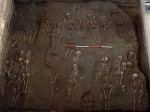 Archaeologists excavating under the Old Divinity School of St John’s College, Cambridge, have discovered one of the largest medieval cemeteries in Britain. The first remains on the site were found during renovations to the college’s Victorian building from 2010 to 2012. The discovery was kept under wraps until 2015, when Cambridge announced that archaeologists had unearthed the intact skeletal remains of 400 individuals, plus the disarticulated remains of close to 1,000 more people. The bodies were interred in the cemetery of the medieval Hospital of St John the Evangelist, the college’s namesake. It was in use between the 13th and 15th centuries and is one of the largest medieval hospital burial grounds ever discovered in Britain.
Archaeologists excavating under the Old Divinity School of St John’s College, Cambridge, have discovered one of the largest medieval cemeteries in Britain. The first remains on the site were found during renovations to the college’s Victorian building from 2010 to 2012. The discovery was kept under wraps until 2015, when Cambridge announced that archaeologists had unearthed the intact skeletal remains of 400 individuals, plus the disarticulated remains of close to 1,000 more people. The bodies were interred in the cemetery of the medieval Hospital of St John the Evangelist, the college’s namesake. It was in use between the 13th and 15th centuries and is one of the largest medieval hospital burial grounds ever discovered in Britain.
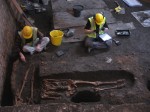 Historians have known since the mid-20th century that there was likely a cemetery under St John’s College, but they had no idea it was so massive. The hospital was founded by the community in 1195 to care for the indigent. It was a small structure in its infancy, but grew into a large institution that cared not just for the poor, but also for other residents and Cambridge University scholars. While the hospital did have support from the Church, the
Historians have known since the mid-20th century that there was likely a cemetery under St John’s College, but they had no idea it was so massive. The hospital was founded by the community in 1195 to care for the indigent. It was a small structure in its infancy, but grew into a large institution that cared not just for the poor, but also for other residents and Cambridge University scholars. While the hospital did have support from the Church, the 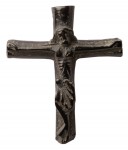 cemetery was a lay institution and the burials reflect this status in their simplicity. There is very little evidence of clothing or grave goods. A few artifacts have been found but it’s not clear from their positions that they were interred with the bodies. The vast majority of burials were done without coffins, many without even a shroud, likely because of the majority of patients at the hospital were poor.
cemetery was a lay institution and the burials reflect this status in their simplicity. There is very little evidence of clothing or grave goods. A few artifacts have been found but it’s not clear from their positions that they were interred with the bodies. The vast majority of burials were done without coffins, many without even a shroud, likely because of the majority of patients at the hospital were poor.
 The intact skeletons were found neatly buried in rows, but they were just the last group buried in those plots. Archaeologists discovered six “cemetery generations” on the site, meaning six complete turnovers of the space. Older remains would be taken to the charnel house or the bones removed to make room for new bodies to be buried in the newly vacated areas. Despite the turnover, archaeologists also found gravel paths, a well and seeds from a number of flowering plants in the cemetery. This indicates the graves were tended to by the community, and the cemetery was less of a boneyard and more of a park-like space where people could pay their respects and grieve their dead. That’s not something you find often in cemeteries of hospitals for the poor.
The intact skeletons were found neatly buried in rows, but they were just the last group buried in those plots. Archaeologists discovered six “cemetery generations” on the site, meaning six complete turnovers of the space. Older remains would be taken to the charnel house or the bones removed to make room for new bodies to be buried in the newly vacated areas. Despite the turnover, archaeologists also found gravel paths, a well and seeds from a number of flowering plants in the cemetery. This indicates the graves were tended to by the community, and the cemetery was less of a boneyard and more of a park-like space where people could pay their respects and grieve their dead. That’s not something you find often in cemeteries of hospitals for the poor.
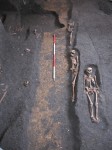 Also unusual for a medieval charity hospital graveyard is the lack of young women and infants. Out of the identifiable remains, half of them were women, most of them between 25 and 45 years old. Given the high rates of death in childbirth of both mothers and babies at the time, you’d expect to see more of the former and at least some of the latter. Historic research explained this imbalance. In 1250 the hospital promulgated an ordinance that prohibited the care of pregnant women. Its focus was to be “poor scholars and other wretched persons,” as long as said wretched were not carrying future wretches.
Also unusual for a medieval charity hospital graveyard is the lack of young women and infants. Out of the identifiable remains, half of them were women, most of them between 25 and 45 years old. Given the high rates of death in childbirth of both mothers and babies at the time, you’d expect to see more of the former and at least some of the latter. Historic research explained this imbalance. In 1250 the hospital promulgated an ordinance that prohibited the care of pregnant women. Its focus was to be “poor scholars and other wretched persons,” as long as said wretched were not carrying future wretches.
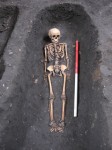 The hospital of St John the Evangelist was long said to have been in active use during the Black Death (1348-1350), but archaeologists found no evidence of this. There were no osteological indications of plague on any of the bones and no mass graves of the types most commonly used to dispose quickly of the infectious dead. The dead of St John will nonetheless be of aid to scholars researching the effect of the Black Death on Cambridge. The University’s McDonald Institute for Archaeological Research has just received a £1.2 million grant from the Wellcome Trust to study how the plague affected the city.
The hospital of St John the Evangelist was long said to have been in active use during the Black Death (1348-1350), but archaeologists found no evidence of this. There were no osteological indications of plague on any of the bones and no mass graves of the types most commonly used to dispose quickly of the infectious dead. The dead of St John will nonetheless be of aid to scholars researching the effect of the Black Death on Cambridge. The University’s McDonald Institute for Archaeological Research has just received a £1.2 million grant from the Wellcome Trust to study how the plague affected the city.
A spokesman said: “This collaborative project, with Professor John Robb as PI and collaborators Dr Toomas Kivisild, Dr Piers Mitchell, and Mr Craig Cessford, explores the historical effects of major health events such as epidemics.
“It will combine multiple methods (archaeology, history, osteoarchaeology, isotopic and genetic studies of both human and pathogen aDNA) to study the people of medieval Cambridge.
“It will use the recently excavated large sample of urban poor people from the Hospital of St. John, complemented by comparative samples from other medieval social contexts and other historical periods.
By comparing samples from before and after the Black Death epidemic of 1348-50 for a wide range of social and biological indicators, this new research aims to reveal how the plague changed human well-being, activity, mobility health and the genetic constitution of Europe.
Long ago, on a Spring morning I walked the length of the Backs in Cambridge, to enter St John’s to teach some Natural Sciences to an undergraduate confined to his rooms as a result of a nasty accident. His rooms turned out to be on the river.
I looked around: “Undergraduate heaven, this” I opined. He replied “I can’t sleep for the fookin’ ducks”.
There’s no pleasing some people.
Don’t know if this was a legit comment or not but I hope the guy’s alright. As for the ducks, I can’t say I can relate. I live next to a river as well and I’ve never had noise problems from them.